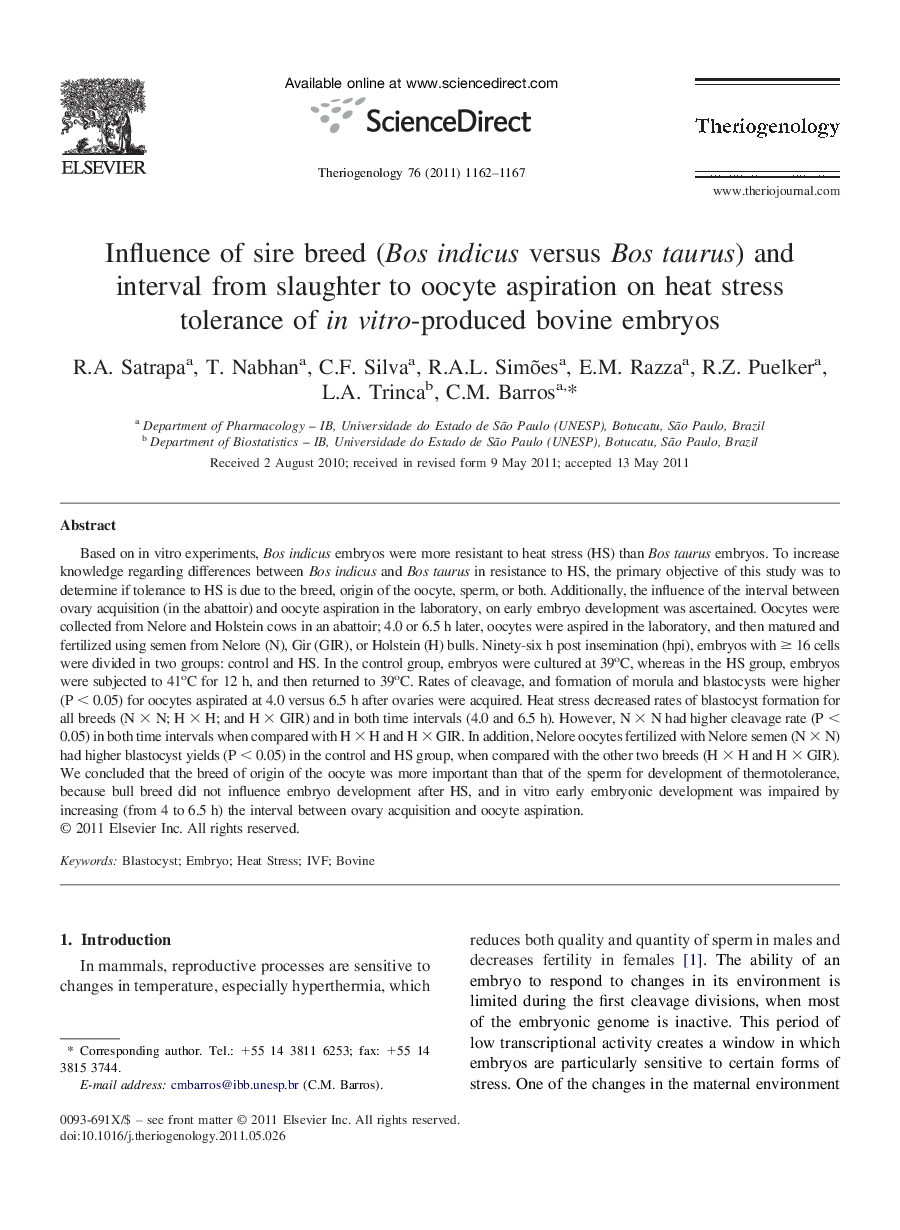| کد مقاله | کد نشریه | سال انتشار | مقاله انگلیسی | نسخه تمام متن |
|---|---|---|---|---|
| 10892614 | 1082110 | 2011 | 6 صفحه PDF | دانلود رایگان |
عنوان انگلیسی مقاله ISI
Influence of sire breed (Bos indicus versus Bos taurus) and interval from slaughter to oocyte aspiration on heat stress tolerance of in vitro-produced bovine embryos
دانلود مقاله + سفارش ترجمه
دانلود مقاله ISI انگلیسی
رایگان برای ایرانیان
کلمات کلیدی
موضوعات مرتبط
علوم زیستی و بیوفناوری
علوم کشاورزی و بیولوژیک
علوم دامی و جانورشناسی
پیش نمایش صفحه اول مقاله

چکیده انگلیسی
Based on in vitro experiments, Bos indicus embryos were more resistant to heat stress (HS) than Bos taurus embryos. To increase knowledge regarding differences between Bos indicus and Bos taurus in resistance to HS, the primary objective of this study was to determine if tolerance to HS is due to the breed, origin of the oocyte, sperm, or both. Additionally, the influence of the interval between ovary acquisition (in the abattoir) and oocyte aspiration in the laboratory, on early embryo development was ascertained. Oocytes were collected from Nelore and Holstein cows in an abattoir; 4.0 or 6.5 h later, oocytes were aspired in the laboratory, and then matured and fertilized using semen from Nelore (N), Gir (GIR), or Holstein (H) bulls. Ninety-six h post insemination (hpi), embryos with ⥠16 cells were divided in two groups: control and HS. In the control group, embryos were cultured at 39°C, whereas in the HS group, embryos were subjected to 41°C for 12 h, and then returned to 39°C. Rates of cleavage, and formation of morula and blastocysts were higher (P < 0.05) for oocytes aspirated at 4.0 versus 6.5 h after ovaries were acquired. Heat stress decreased rates of blastocyst formation for all breeds (N à N; H à H; and H à GIR) and in both time intervals (4.0 and 6.5 h). However, N à N had higher cleavage rate (P < 0.05) in both time intervals when compared with H à H and H à GIR. In addition, Nelore oocytes fertilized with Nelore semen (N à N) had higher blastocyst yields (P < 0.05) in the control and HS group, when compared with the other two breeds (H à H and H à GIR). We concluded that the breed of origin of the oocyte was more important than that of the sperm for development of thermotolerance, because bull breed did not influence embryo development after HS, and in vitro early embryonic development was impaired by increasing (from 4 to 6.5 h) the interval between ovary acquisition and oocyte aspiration.
ناشر
Database: Elsevier - ScienceDirect (ساینس دایرکت)
Journal: Theriogenology - Volume 76, Issue 6, 1 October 2011, Pages 1162-1167
Journal: Theriogenology - Volume 76, Issue 6, 1 October 2011, Pages 1162-1167
نویسندگان
R.A. Satrapa, T. Nabhan, C.F. Silva, R.A.L. Simões, E.M. Razza, R.Z. Puelker, L.A. Trinca, C.M. Barros,